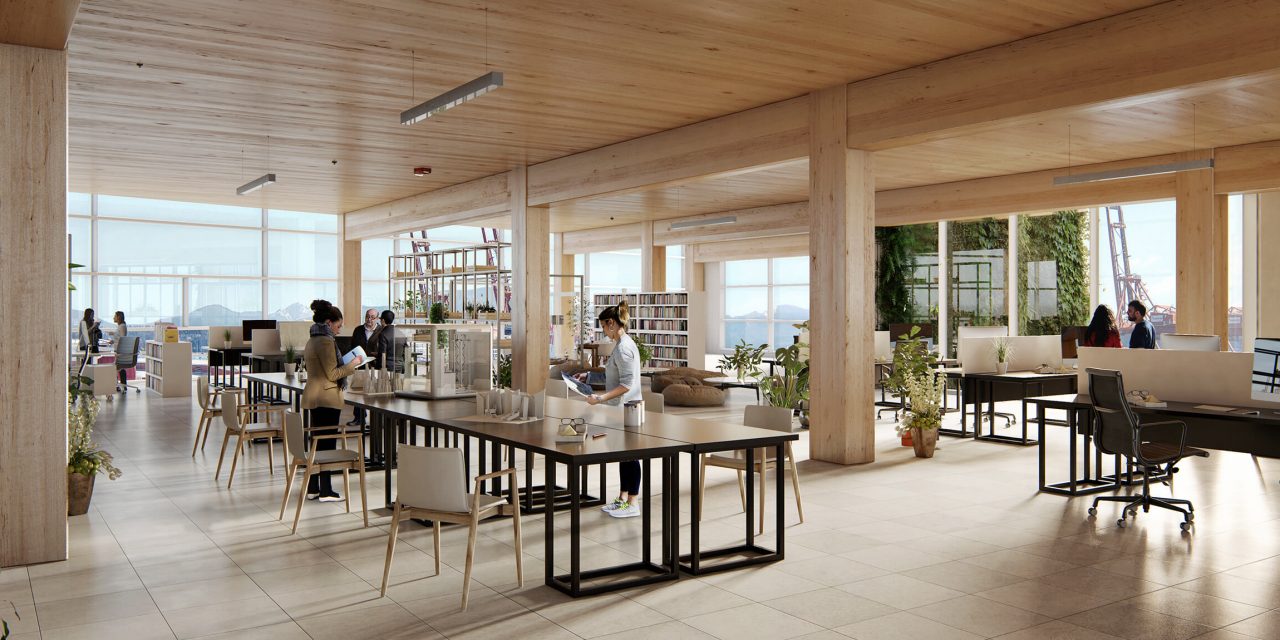Environmentally responsible practices aren’t only for developers who want to “go green.” Sustainable strategies can have real economic benefits, too. Here are 5 ways to build a more profitable portfolio.
- Preserve character, reduce costs
Creatively remodelling existing buildings honours a community’s history and preserves local character, which are appealing features for prospective tenants. Using materials that are already in place saves money and lessens environmental impacts. According to the American Institute of Architects, reusing structures reduces embodied carbon by 50-70%. And a 2016 study found that adaptive reuse projects cost less per square foot than new construction.
“We believe that adaptive reuse not only adds value by creating a distinctive and unique workspace for our users, but also contributes meaningfully to a sense of community,” says Edmund Wong, director of asset and environmental sustainability at Allied Properties in Toronto. “Preserving historical elements of existing structures and reducing our environmental impact is something we always strive for. Reduction of embodied carbon and any realized cost savings associated with these activities are a bonus.”
- Repurpose furnishings and fit-outs
The “bones” of a building aren’t all that can be repurposed: Interior components can be reused and recycled, too.
For instance, the U.S. Green Building Council’s (USGBC) Washington, D.C., office renovation incorporates about 80% reused and repurposed materials, including drywall, ceiling tiles and grids, glass panels, terrazzo, carpeting, shades, furnishings, and modular workstations. Items that couldn’t be reused were recycled, donated, or auctioned. Operational carbon was reduced via lighting and HVAC occupancy sensors, low-flow water fixtures, appliances certified as energy efficient, and sustainable refrigerants. “We serve as an example,” says Melanie Mayo-Rodgers, the USGBC’s director of facilities. “We wanted to make this replicable for other buildings and serve as a template for how you could reuse structures, materials, equipment, and furniture, and use strategic demolition to preserve still more construction materials.”
Similarly, when the global design and engineering firm Arup needed to fit out the interior of its new London workplace, project leaders reused existing furniture and chose new design elements that could be disassembled and moved as needs changed over time. “We’re looking at whole-life carbon on projects,” says Nick Jackson, a director at Arup. “We’re looking at projects holistically, not just at energy usage. It’s fundamental to how we think and work.”
Thinking of the entire life cycle of a building and its interiors can save money and result in beautiful outcomes, Jackson says. “This was a collaboration between Arup and Perkins&Will to try and embed that thinking in all parts of the process: Let’s buy less, let’s use less if we can. But when we do use material, let’s design it elegantly, beautifully. Let’s make it look really good.”
- Leverage emerging building technologies
In new construction, sustainable technologies and techniques can reduce the costs associated with labor, material procurement, and waste disposal.
“I personally have my eye on cross-laminated timber and modular building components as a way to reduce waste and carbon footprint,” says Jordan Selig, executive vice president of Selig Real Estate, a Seattle-based developer.
Modular construction techniques allow for faster assembly, better quality control, and reduced expenses, which ultimately help builders save time and money. A 2023 McKinsey report found that modular techniques used in home building can reduce construction costs by up to 20% and accelerate project completion by up to 50%. Cross-laminated timber (CLT) is a sustainable and cost-effective alternative to more typical materials. For example, although its upfront costs are greater than reinforced concrete, research shows that CLT’s longer lifespan and greater salvage value make it at least 2.4% less expensive overall.
- Differentiate your portfolio
As tenants become more attuned to the environmental impacts of their workplaces and residences, they’re asking for carbon performance metrics from owners and property managers. Properties that can deliver this data with demonstrated performance can stand out in the market.
“We are getting more and more questions from our users,” Wong says, adding that tenants want numbers for their ESG reporting, annual updates, and other purposes. To fulfill these requests, Allied discloses the carbon performance of its buildings, the amount of waste that tenants generate, and other data upon request.
“Our users are increasingly aware of these metrics and how they’re performing,” Wong says. “They want to see how they can play their part and help.”
- Encourage higher lease rates by helping tenants save on energy
When considering their lease options, commercial and residential tenants often factor in utilities and other expenses. If a property is designed with energy efficiency in mind, utility costs are reduced and the owner can enjoy a competitive advantage. For instance, utility bills are lower than average for residents of the Oscar Ibirapuera residential building in São Paulo, Brazil, due to sustainable strategies that were built into the design.
“Residents of the Oscar Ibirapuera enjoy up to 52% savings in air conditioning, up to 40% in lighting energy consumption, and up to 16% in water heating,” says Lucas Araujo, director of marketing intelligence at Trisul SA, one of the largest developers in São Paulo. “The initial expense of all our sustainability efforts was only around 1% of construction costs, but residents will appreciate the savings for decades to come.”
To read more visit: https://www.perkinswill.com/insights/5-ways-developers-can-reduce-carbon


